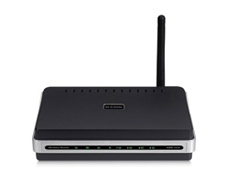D-Link WBR-1310 Wireless G Router
![]()
![]()
![]()
![]()
![]()
![]()
![]()
![]()

Wireless network routers can be somewhat mysterious at times – and eight hours into the installation with nothing more to show for your efforts than some opened, non-returnable product packaging and a selection of cryptic error codes, they can drive the unwary to thoughts of homicide or illicit substances.
Some of the earlier generations of these things were clearly designed by sadistic gorillas.
The D-Link WBR-1310 wireless router is remarkable not so much for its technology – just about anyone can make one of these things, and just about everyone does – but rather, for the craftsman-like polish of its installation. Users who ultimately gave up on programming their VCR clocks will none the less be able to have a D-Link router spitting Internet all over the house in about fifteen minutes.
The installation procedure for the WBR-1310 router is managed entirely by a CD-ROM. Put the CD in your CD-ROM drive and follow the subsequent on-screen cartoon. The software that drives it will configure your router, scope out your Internet connection and bring up your network without your having to perform any task more technologically demanding than clicking on Next.
Bloodied veterans of the router wars will unquestionably wonder if something is missing.
We tried the WBR-1310 wireless router in several installations, including our dreaded satellite Internet modem, which hurls its data through 45,000 miles of outer space before it crashes to earth in northern Ontario. The latter has proven to be a configuration challenge for all our previous routers. The WBR-1310 blew everyone away when it set itself up correctly for the satellite link without any strange messages or frightening noises.
The WBR-1310 hits the ground running as soon as it’s set up, with its hardwired router functions and wireless working correctly. It’s worth noting, however, that it does so with all its internal security features disabled. As such, as soon as you’re done patting yourself on the back and seeing if there’s anything interesting left in the box, you should unquestionably log into the WBR-1310 with a web browser to enable one of its available wireless security options and change the network name for the router.
Failing to do so will endear you to every geek and hacker within radio range – as a rule, these aren’t the sorts of friends you’re likely to want.
It’s probably worth noting that the WBR-1310, like many contemporary bits of technology, comes with almost no printed documentation. Its manual is a PDF file on its install CD, for which you’ll probably have undertake a bit of a search. The manual includes the IP address of the router, which you’ll need to access it and configure its security options.
Inexpensive, obese with features and a pleasure to install, the D-Link WBR-1310 wireless router is the best such device we’ve encountered thus far. It’s unquestionably preferable to the no-name mystery routers available from most big-box electronics retailers. The latter will save you seven dollars at the checkout, but they’ll leave you with innumerable head-shaped dents in your walls that will unquestionably cost a lot more than seven dollars to have fixed.